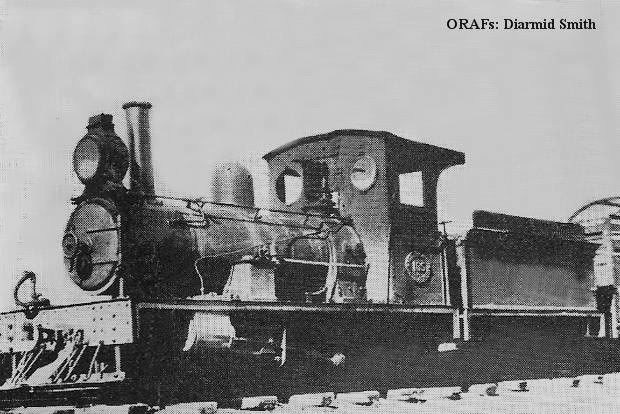
Above: This ex-Beira railway 2 ft. gauge Falcon built 4-4-0, No. 105 was bought and put into service on the South African Railways in 1915 on the Fort Beaufort branch line. It was subsequently sold to a Rhodesian firm and used for logging on the south bank of the Zambezi near Victoria Falls.
Photo from A. H. Croxton collectionOne of the gems of the locomotive collection in the Rhodesia Railway Museum is the Beira Railway 2 ft. gauge engine No. 15, a little 4-4-0 built in 1897 by the Falcon Engine and Car Works and one of the batch that formed the motive power of the original narrow gauge-line between Beira and Umtali. These light locomotives did sterling work in the 1890s up to August 1900 when the widening of the Beira line to the 3 ft. 6 in. standard South African gauge was completed.
When this widening was finished most of the narrow gauge engines, carriages and wagons were stabled at Vila Machado, then known as Bamboo Creek. While some were withdrawn for the Ayrshire Railway most of these locomotives stood rusting away with grass growing over them in the sidings, eventually being acquired by Mr. Alfred Lawley who had been George Pauling's manager during the Beira railway construction and later with other railway works. There these locomotives stood until 1915.
With the outbreak of World War 1 in 1914 the then Union of South Africa was soon engaged in preparing for an invasion of German South West Africa and by early 1915 this was well in hand. At that time the lines from Swakopmund to Windhoek and Otavi were narrow gauge (600 mm) and when the territory was captured from the Germans it was found that most of the locomotives were unfit for service and a number of SAR and other 2 ft. gauge engines were hastily sent up to S.W.A. as replacements. Some of these were purchased from Rand mining companies but it was for the narrow gauge lines on their own system that the SAR cast around urgently for engine power and heard of Lawley's collection at Bamboo Creek.
These were examined on their dump and thirteen Falcon 4-4-0 tender engines were purchased from Lawley and sent down to SAR workshops for rehabilitation. Of these, nine were reconditioned at Durban, Uitenhage and Salt River for service on SAR narrow gauge lines, but the remaining four were in too bad a state and their parts were utilised as spares for the other nine. These engines were classified as the "NG 6" class and numbered 96 to 98 and 101 to 106 but they were soon christened "Lawleys" by the staff and always retained that cognomen. It is remarkable that after 15 years standing out unattended in the open of the Mozambique climate that these engines could have been repaired for further useful service and it is a tribute to their sturdy construction.
In 1915 the SAR were operating more narrow gauge lines than now as several have since been converted to 3 ft. 6 in. The nine Lawleys were soon busily engaged moving trains in various parts of South Africa. Lines on which they were seen included the 149 km between Kalabaskraal, Hopefield and Saldanha; the 287 km long Avontuur Railway from Humewood Road (Port Elizabeth) serving the prosperous deciduous fruit growing area of the Langkloof; and the 54 km Fort Beaufort-Seymour branch for the citrus farmers — all these being in Cape Province. Others worked on Natal narrow gauge lines and two were busy during the construction of the Upington-Kakamas line to serve an agricultural area along the Orange River, one of these heading the inaugural train when the line was opened in 1926.
Of these nine Lawleys only one was scrapped by the SAR, the other eight being sold between 1919 and 1935 to industrial railway operators and performed useful work for many years. Two of these little engines were actually purchased for Rhodesia, one by the Portland Cement Co. near Bulawayo and the other by Mr. Musgrave for Selukwe Chrome Mines to run on railways hauling limestone and chrome respectively. Another purchaser was the Zebediela Citrus Estates in Northern Transvaal for their extensive light rail system and here four Lawleys ended their working lives, two being seen in steam there by the writer as recently as 1958, not long before the lines were replaced by motor transport. Two of these Lawleys are now preserved at Milner Park and Pioneer Park in Johannesburg.
Little did George Pauling and Alfred Lawley think that their Falcons would go on from Beira to lead such versatile lives and help such a widespread system as the SAR in a time of difficulty.
Extracted and recompiled by Eddy Norris from the Rhodesia Railways Magazine May 1973 which was made available by Diarmid Smith. Thanks Diarmid
No comments:
Post a Comment